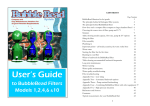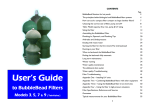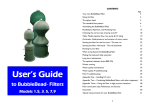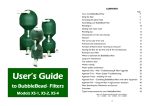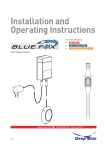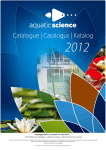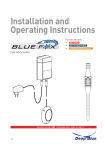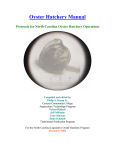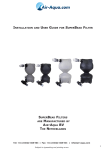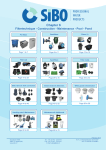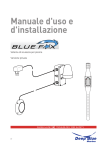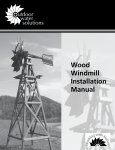Download User's Guide - Absolute Koi-Koi Supplies - Koi dealer
Transcript
User’s Guide for PolyGeyser Filter Model PG - 6.5 CONTENTS Section One: Installing the PolyGeyser Siting the filter 3 Assembling your PolyGeyser Filter Plumbing-In 4 -7 7 Airbreaks / Dealing with waste water Plumbing tips 8 8 -9 Choosing the correct size of water pump Strainers / Sieves 9 - 10 10 Choosing and fitting a UV unit and airpump 10 - 11 Aeration of filtered water returning to the pond Starting the filter for the first time / Test run / Inserting the beads 11 11 - 12 Filter operation Regulating the air pump 12 13 Running-in your filter / Establishing nitrification 13 - 14 Section Two: Maintaining the PolyGeyser filter When and how to flush waste from the PolyGeyser Long term maintenance 15 15 Winter running / Water quality maintenance 16 Appendices Appendix One – Filter Troubleshooting Appendix Two – Water Quality Troubleshooting 17 - 18 19 - 21 Appendix Three – Combining the PolyGeyser with other equipment Appendix Four – Using the filter in high pressure situations 22 23 Filter Specifications Guarantee 23 24 SECTION ONE: INSTALLING THE POLYGEYSER GREAT WATER QUALITY Congratulations on the purchase of your new filter. Your PolyGeyser filter uses tested bead technology for the efficient biological filtration of koi ponds, fish holding systems and aquaculture facilities. EASY CLEANING The PolyGeyser’s major advantage is its self-cleaning procedure which takes place automatically, at a frequency set by you, and with no wet hands! Dirt is extracted from the filter media and collects in the base of the unit. Then it can be simply flushed to waste by turning one valve. The regular self-cleaning process removes wastes from the direct water flow before they have fully broken down. This greatly reduces the nutrient loading on your system and further improves water quality for the fish. VERSATILE and EASY TO FIT AND USE Fit the PolyGeyser near your existing pond, or at a distance. Site it below the pond or above the pond. Hide it behind a bush or fence, or even in a shed or garage. The unit takes up less space than many other types of filter, and no labour intensive excavation is necessary to site it. 2 Siting the filter Although the filter can be some distance from the pond, a more powerful pump may be required to overcome the friction loss in longer pipe runs. CHOOSE A SITE CLOSE TO A DRAIN FOR THE WASTE WATER Sediment-laden water is drained from waste outlet. This water can be piped to a convenient nearby drain but ensure that it can handle the level of solids without blocking. The waste-water can also be used for irrigation in gardens (provided that treatments and salt have not been used in the pond). Any pipework connected to the waste outlet should not restrict flow and should run slightly downhill without undulations. If no drain is available, a sump tank can be sited below the filter and an automatic solids-handling sump pump can pump the waste-water away. Using a separate sump and sump pump to dispose of waste water. This is an ideal option for sites set below local drainage, or where waste water is to be pumped to irrigation pipes. FIRM BASE For safety the filter must be mounted on a firm level base as it is heavy when full of water and will vibrate during the backwash process. The backwash may not proceed correctly if the filter is not level. Ideally, fit on a purpose built slabbed area or concrete plinth. MOVING THE FILTER The filter is heavy, do not attempt to move it without extra assistance. Do not carry the filter using any protruding fittings, otherwise damage could occur. FUTURE ACCESS It is necessary to access the waste outlet valve on a regular basis. The other fittings on the filter should also be readily accessible and not permanently boxed in. You may wish to pull out the inlet/outlet strainers at some stage in the future, and these require clearance. OUTSIDE OR UNDER COVER? The filters are suited to outdoor use but if sited in an outhouse, shed or garage, they will not only be out of sight from the pond but also better protected from severe frosts (see the Winter Running section – page 16). 3 Assembling your PolyGeyser Check that you have all the relevant parts before commencing: You should also have approximately 6.5 cubic feet of bead media in sacks. Internal dividers have already been fitted into the unit and the two part exterior moulding has been sealed together and reinforced with steel rings and bolts in the factory. The moulding is not intended to be dismantled by the user please note the warranty conditions at the end of this booklet. To run the filter you will also need a suitable water pump with strainer (see p. 9 - 10), a suitable air pump (see p. 11), some PVC glue and any interconnecting pipe & fittings. 4 ASSEMBLY STAGES Ideally, move the filter to its final mounting position. Do not install the bead media at this stage. Check that any packing debris is brushed out of the filter body threads. The threads on all plumbing fittings must be given a coating of the supplied Teflon sealant before being screwed into place. Alternatively they can be wrapped with several winds of PTFE plumbers’ tape to ensure that the joints are fully watertight and to simplify any future disassembly. ° 1) If using PTFE tape rather than the liquid sealant, note the direction that the tape is wound on. If it is wound on the wrong way, it will tend to peel off as the fitting is screwed in. When using standard thin PTFE tape we recommend at least five layers of tape be wound on for a really watertight seal. (To reduce the risk of ‘salt creep’ on marine systems, use the supplied liquid sealant or aquarium silicone sealant, and also spread it on the female threads just before the fitting is inserted) 5 2) Insert the inlet and outlet strainers into the appropriate holes on the filter. The screens may have a tight fit through the pre-cut hole in the filter body. To avoid cross threading, turn the fitting anti-clockwise a half turn or so until the threads click into place, then screw clockwise. Tighten firmly by hand using the knurled section closest to the filter body. ° 3) Apply teflon sealant or PTFE tape to one half of the close nipple fitting and thread it into the waste drain. ¯ 4) Apply teflon sealant or PTFE tape to the other half of the close nipple fitting. ° 5) Fit the waste discharge ballvalve to the nipple. Tighten it by hand and leave the handle facing upwards. ¯ 6) You require PVC pipe glue and a short length of 2” PVC pipe. Ensure that the fittings and pipe are free of burs, clean, grease-free and dry. Attempt a dry fit before using glue. Ensure that the checkvalve is mounted so that it will flap shut when in position i.e. pointed end uppermost and ‘TOP’ or ‘Horizontal Use This Side Up’ marking on upper surface. Glue the short length of pipe into the outlet (pointed end) of the supplied water-inlet checkvalve (flap-valve), and glue the supplied water inlet elbow to the other end of this pipe stub. Give the glue sufficient time to set ! ° 7) Glue the other end of the water inlet elbow into the inlet on the filter. The angle of the pipe/inlet-checkvalve can be adjusted at a later time by loosening the slip ring on the dismountable inlet fitting. For correct operation the checkvalve must always be mounted so that the flap falls shut. 6 ° 8) Fitting the air-flow meter. The barbed air-inlet fitting and two elbows need a small amount of Teflon sealant applied to the threads before they are fitted. Once the elbows have been screwed into the flow meter it can be mounted onto one of the bolts on the filter lip using the bracket supplied. The flow adjustment knob is at the base of the flowmeter. ¯ 9) Screw the barbed fitting into the filter and fit the airline, incorporating the air checkvalve between the filter and the upper outlet on the meter. This prevents water flowing back into the meter or airpump. Make sure that the airline is pushed on firmly, it will be operating under some pressure. 10) Apply Teflon sealant or PTFE tape to the white plug and fit this into the opening on the top of the filter. This will be removed at a later stage to allow the beads to be added. Do not fill the filter with beads at this point. The filter is best filled with water and given a test run without beads. If the test run points out leaks in the system, it will be easier to make any pipework modifications whilst the filter has no beads in it. Plumbing in INLET AND OUTLET PIPEWORK The sockets in the checkvalve and on the filter outlet can be plumbed using 2” solvent weld fittings or adapted to flexible hose. Ask your dealer about appropriate fittings. All pipework must be fully supported so that it does not put undue strain on the filter fittings. The filter can vibrate during the backwash process so there should be sufficient length of pipe or hose to allow for some minor filter movement without putting fittings under stress. OUTLET PIPEWORK The maximum recommended filter flow is 300 litres per minute (4,000 gph). To deal with this flowrate the outlet should be fitted with no less than 2” pipework. Consider using larger pipework (2½” or 3”) on very long runs (over 15m). Using smaller pipework will reduce flows, reduce pump efficiency, and could create unwanted pressures inside the filter. Consider whether you will need an air-break in the outlet pipework to allow air to escape from the outlet water following a filter backwash (see diagram on next page). INLET PIPEWORK Use 1½” or 2” connecting pipework between the pump and the filter. Larger bores will aid pump efficiency and reduce friction losses in flow. 7 Air-breaks Consider whether you will need an airbreak in the outlet pipework to allow air to escape from the outlet water following a filter backwash. An air-break is supplied naturally in level outlet pipes (top picture). Where the pipe runs down towards the pool/tank water it is best to introduce an air-break (middle picture), especially if the end of the pipe actually enters the water. Where the pipe enters below the water level, you should include an air-break tee to prevent excessive amounts of bubbling in the pond following a backwash (lower picture). Filters mounted in such sites will need a check-flap-valve or temporary plug at the pool inlet (and after the airbreak) to allow the filter to be drained during maintenance. WASTE OUTLET PIPEWORK A hosetail can be fitted to the 1½” waste outlet valve and hose attached to lead waste water to an appropriate drain. Avoid restricting flow from the waste outlet. Avoid using excessive numbers of bends or excessive lengths of undulating hose as this can encourage airlocks. If extending the waste outlet, consider installing a sight-glass in the pipework to let you see how much dirt there is in the waste water. Dealing with waste water Check that your drains or soakaway can cope with the level of solids in the waste water. Waste water is often high in organic waste and must not be emptied directly into natural water bodies. You may need permission to direct this waste into public sewers. Plumbing tips: * To minimise pressure loss on the inlet and backpressure on the outlets: - use larger bore pipe/hose wherever an option is possible - all pipe fittings (including UVs) must be as large bore as possible (see UV fitting on p. 10) - avoid multiple fittings with internal restrictions - do not use valves on the top filter outlet! (see Appendix Four) - consider swept rather than knuckle bends and keep bends to a minimum - flexible hose should be heavy duty, crushproof, opaque, smooth bore, and suited to the pressures likely to be found in the system. 8 * To prevent strain on the filter inlet/outlet fittings: - support pipework with pipe-clips etc., it is heavy when full of water! - avoid the weight of pumps or external UVs being carried by the inlet/outlet fittings. Failure to do so, could void your guarantee. * To prevent leaks of water out, or air in: - use Teflon sealant or PTFE plumbers tape on all threaded fittings - use solvent cleaner on any solvent-weld fittings before use and use ample amounts of an appropriate glue. Set up solvent fittings in a ‘dry run’ to check positionings before final gluing takes place. Glue needs time to set! - use correctly sized hosetails and appropriate hose clips. If the hose is slightly loose on the hosetail, run a strip of silicone sealant (or ‘Innotec’ Adheseal) around the hosetail before fitting the hose and clamping down. Clips can distort hose causing leaks if over-tightened. TIP: To reduce this risk, wrap the end of the hose with a single layer strip of rubber liner before fitting the clip. * To prevent excess pump vibration reaching the filter: - use flexible hose in the outlet pipework from surface mounted pumps. * To avoid corrosion or poisoning problems: - avoid metal fittings - if metal parts are used, choose quality materials e.g. (316) stainless steel. (The threads on the PolyGeyser ports are marine grade aluminium.) Choosing the correct size of pump Pump size is related both to the volume it pumps and the pressure with which it pumps. The recommended flow for the PolyGeyser 6.5 is between 100 and 300 lpm (1,300 and 4,000 gph). You should also consider how frequently you wish to turn over the water in your system. We recommend turning over koi ponds at least once every two hours, more densely stocked holding systems will need to be turned over more frequently e.g. one to four times per hour. Lightly stocked goldfish ponds need only be filtered once every three hours. THE MINIMUM HEAD: The minimum head of the pump should be at least two metres more than the effective working head in the plumbing system. The working head is the vertical distance between the water level in the originating pond/tank, and the highest point in the filter/pipework loop that returns to the pond. Flow rates should be calculated at the pump’s working head, not the maximum pump flows quoted by some manufacturers, which are taken at zero head! MAXIMUM PRESSURES: The filter hull is designed to handle start-up pressure surges to 1.1 bar (15psi) but the maximum working pressure of the PolyGeyser 6.5 is 0.7 bar (10 psi) equivalent to a head of 7 metres. We recommend using pumps rated at no more than 7 metres maximum head. If you are using a high-pressure pump (e.g. a swimming pool pump) these are likely to exceed the pressure rating. For all pumps with a quoted head exceeding 7 metres it is essential to use a bypass tee before the filter inlet, with a pressure regulating spring-check-valve to prevent excess pressures building on the filter. (Appendix Three). A pressure gauge is also very useful in such situations. Subjecting the filter to working pressures in excess of 0.7 bar will void the warranty. 9 WHICH PUMP? Your dealer should be able to recommend suitable pump models from the brands available in your area, also see our website. Remember that a small pump may not suit longer pipe runs or high head situations. If in doubt, it is better to have a slightly larger pump and use a valve on the pump, or a bypass to control excess flow, rather than to have a small pump with no spare capacity. Surface mounted pumps should be of the self-priming type or installed in a way that ensures they cannot run dry. Model Model number refers to cubic feet of media PG-6.5 1.50m high 0.92m dia. Max. Rec. FlowRate gph (lpm) 4,000 300 Maximum Pond Volume Gallons (Litres) at maximum rec. flow rates 2 hour - turnover - 3 hour Standard Stock Light Stock 8,000 36,000 12,000 54,000 Recommended Suggested Pump Size Pre-straining is essential Pump maximum head at least 2.0 metres more than the working head, up to a maximum 7.0 metre head Max. Feed Rate per day* Max. Feed Rate per day* (Standard Beads) (EN Beads) UV for algae control at standard stock volume in full sun # > 80w e.g. 2 x 55w or 3 x 30w 3.0 - 6.0 lbs. 4.5 - 9.0 lbs. 1.4 - 2.8 Kg 2.1 - 4.2 Kg N.B. A pressure release bypass is essential if using high pressure pumps rated with a combined suction & delivery head exceeding 7m (0.7 bar). Gallons are imperial, multiply by 1.2 for US Gallons. # For control of parasites etc., much higher levels of UV are required. *At these feed ranges, the lower limit will give the best water quality and is recommended for viewing systems and broodstock. The upper limit is for aquaculture ongrowing systems. STRAINERS / SIEVES PolyGeyser filters contain internal screens with slots of c. 1.5 mm spacing on the outlet designed to prevent loss of beads. The inlet diffuser has c. 8mm holes. The backwash process helps to clean these screens, but the rate of internal screen clogging will be reduced if solids of greater than 1.5 mm and strands of blanketweed are removed before being pumped to the filter. This greatly reduces the need for screen maintenance and reduces the rate of clumping of beads. Therefore it is very important to fit an appropriate strainer/sieve before the inlet (See Appendix Three). The correct size of ultra violet (UV) unit A UV unit is the most useful piece of extra equipment to use with a PolyGeyser filter as it helps to control smaller free floating algae and blooms of bacteria which are too small (< 5 micron) to be readily captured by the filter. Closed chamber UVs (with a protective quartz sleeve for the lamp) are recommended. Despite small differences in design, the major factor in most UV unit performance is the wattage of the lamp. See the preceding table for the correct wattage for green water control. Where the pond is heavily shaded, control may be achieved with 50% of the wattages listed. In very shallow ponds and in areas where sunlight intensity is greater, a higher wattage of UV light may be required. A much higher wattage is required for full sterilization of parasites and other pathogens. Maintain the UV unit as recommended by the manufacturer. Choose a unit with wide bore connections, rated for flows in excess of the maximum filter flow, so as to prevent back-pressure across the UV. In some cases it may be necessary to use two or more units in parallel. PLUMBING A UV INTO THE SYSTEM Any UV unit is best fitted after the pump and before the filter or alternatively in a separate loop. Ensure that your UV unit is designed to cope with the pressures produced by your pump. Although a wide bore UV unit (2” minimum connections) could be plumbed in after the filter (where cleaner water flow reduces sleeve fouling), this has disadvantages. The pulsing of air from the filter outlet following backwash can leave air bubbles trapped inside the UV unit, and great care will need to be taken in the fitting and plumbing of the unit in such situations to minimise this. 10 The correct air pump The air pump used to drive the automatic backwash should be a reliable design suited to supplying moderate volumes of air at a moderately high pressure 24 hours per day. In general, only larger units are capable of supplying air at the recommended minimum 0.4 bar (capable of pumping to 4m depth). Types based on rubber diaphragms tend to wear rapidly when working at this pressure continuously, so we recommend piston type air-pumps such as the Nitto Medo LA45. Other types may be listed on our website. Mount the pump safely, as recommended by the manufacturer. With larger output pumps it may be possible to use the pump at the same time to drive air-stones in the pond, but care must be taken to ensure that sufficient pressure is available at all times to keep the PolyGeyser backwash function operating. Important points AERATION OF FILTERED WATER RETURNED TO THE POND Although the regular PolyGeyser backwash automatically charges the water with air, system water must also be aerated at some other point as both the fish and the filter bacteria can consume high amounts of oxygen, especially in warm weather. Returns that encourage some re-aeration of the water are strongly recommended, e.g. cascades. Using a sieve unit before the pump will also greatly enhance aeration of the water. Venturi devices are not suited to returns on PolyGeyser units. Starting the filter for the first time - test run - and inserting the beads Start up the pump, but leave UVs off at this stage. The filter will start to fill with water. On this first time of running you may wish to direct the first few gallons of water to waste, as this will flush out any dust from the pipework. Check carefully for leaks. If any of the threaded fittings leak, and gentle tightening does not help, the filter will need to be drained, the offending fitting removed and rewound with extra sealant or PTFE tape before refitting. Do not attempt to seal such leaks by smearing the outside of the fittings with sealant, glue, mastic or repair compounds. This rarely solves the problem, it may make future dismantling difficult or impossible, and it could damage the filter body - voiding your guarantee. Leaks from solvent weld joints will need to be completely dried before attempting to reseal them. After a leak-free test run, turn off the pump. If the filter is fitted above pool level, excess water will drain from the top of the unit back into the pond. If the filter is sited below pool level, a plug should be temporarily fitted in the pool return but the airbreak tee should be left open. Open the waste discharge for around 50 seconds to lower the water level in the unit but do not drain the unit more than half empty! Beads can now be added to the filter. Remove the plug top outlet and use a wide necked funnel to guide beads into the filter. Only use the recommended type and quantity of beads !! Re-fit the top plug using fresh sealant/PTFE if required. 11 Starting the filter for the first time - with beads Start up the pump, but leave UVs off at this stage. The filter will start to fill with water and you should hear the beads gently rattling against the side of the filter body. The noise will stop once the filter is full. On this first time of running you may wish to direct the first few gallons of water to waste, as this will flush out any dust from the beads. It is useful to measure the flow rate of water returning to the pond. Use a graduated bucket and stopwatch to calculate the flow rate. Adjust the flow rate as required by using a flow regulator on the pump outlet. Do not fit flow regulators on the filter outlet (see Appendix Four). If you have fitted a pressure gauge, note the typical pressure on the dial and make a note of it Filter Operation HOW THE UNIT WORKS Water enters the filter in the centre of the chamber and flows up through the floating beads and out to the pond. The air-pump, injects air into the air collection chamber. When it is full the air is then automatically released up through the bed of beads, churning loose captured debris (this is the geyser part). The water pump continues to run. The beads fall into the ‘drop zone’ below the water intake, so the new pond water washes wastes down through the beads to the chamber below. As the filter refills, the beads float up to the top of the filter, and filtration restarts. Some air will be expelled from the outlet. It is quite normal for the first few gallons of water returning to the pond to be a little cloudy. This is not harmful and the filter will soon remove these particles. The air pump can be adjusted to fill the chamber and trigger automatic cleaning every two to six hours, keeping the filter media bed at an optimum performance level and debris free. In the bottom chamber of the filter, the captured debris settles out, and can be released by simply opening a valve for a few seconds every few days at the convenience of the owner (see Maintenance p.15). The chamber is quite large, so if necessary the filter can go for some time without wastes being flushed providing feeding rates are moderate. The flushing process uses very little water. There is no need to turn off the water pump to purge the collection chamber. 12 REGULATING THE AIR PUMP By turning the knurled knob on the air-flow meter the rate at which the air chamber in the unit fills can be controlled, and accordingly, the backwash frequency. Amount fed per day lb (Kg) Ÿ 1.5 lb (Ÿ 0.7 Kg) cubic ft./hr (Litres per min.) Airflow 1 (0.47) Backwash Frequency (approximate) 3.5 x per day (every 7 hours) 3.0 lb (1.4 Kg) 2 (0.94) 7 x per day (every 3½ hours) 4.5 lb (2.1 Kg) 3 (1.41) 10 x per day (every 2¼ hours) 6.0 lb (2.8 Kg)* 4 (1.88) 14 x per day (every 1¾ hours) 9.0 lb (4.2 Kg)* 5 (2.35) 17 x per day (every 83 mins.) 13.0 lb (5.9 kg)* 5 (2.35) Solids handling capacity for aquaculture additional nitrification may be required * These higher feeding rates are only recommended with EN (Enhanced Nitrification) Beads. At these higher frequencies of backwashing there may be a drop in water clarity. You are best to measure the time between backwashes when setting up the filter and adjust the air flow accordingly, as there will be minor variations in every set up and flow meter. At the backwash, put your ear to the side of the filter and listen to how a normal backwash sounds. As beads tumble clean in the cascade of air bubbles they will rattle against the side of the filter body. You should monitor the backwash occasionally by listening in this way - any change in sound can suggest that beads are clumping and remedial action may be necessary (See Maintenance on p. 15 & 17). Your filter is now tested and operating correctly. The floating bead media packs down in the top of the filter and will soon start to filter out particles. Filtration of finest particles and biological breakdown of wastes also takes place here once the filter has matured. Running-in your filter Your filter should run 24 hours a day to support the biological organisms that will colonise the filter media; just like your fish, they need oxygen and food (the fish wastes) to survive. Although mechanical filtration starts straight away, it can take up to three months for full biological activity to mature, especially in brand new ponds and in cold weather. Patience is necessary during this phase. If there are no fish in the pond, commercial additives are available that contain ammonium salts and nitrites that imitate fish waste and help the filter to mature. There are a number of steps that you can take to aid the maturing process: 1) Do not immediately introduce large numbers of fish. Build up fish stocks gradually, using hardy fish of lower value to begin with. 2) Feed fish more lightly than normal in the first two months, and maintain the backwash frequency at an appropriately lower rate, as per the table above. 3) After the first few days of operation, add a commercial filter seeding agent that contains filter bacteria. Alternatively swill out the debris from an existing active pond filter and pour it into the pond near the pump intake, or in through the top plug on the filter whilst the filter is off. 4) Avoid the use of pond medications during the filter maturing period. Some medications can severely disrupt filter organisms and many medications can temporarily reduce filter activity, especially on the first time of use. If in doubt, ask a specialist before using any treatments. 13 5) Avoid turning on UV units during the first month. The water may green temporarily but this is rarely harmful. You can monitor the maturing process by using standard pond test kits. The most useful ones at this stage are pH, nitrite (NO2), ammonia/ammonium (NH3/NH4) and nitrate (NO3). The pH should remain relatively stable and need only be checked occasionally at this stage. Typically, acceptable pond pH values range from 6.5 to 9.0 with the ideal range for pondfish being between 7.0 and 8.5. ESTABLISHING NITRIFICATION The major soluble waste product produced by fish is ammonia and its ammonium salts, and this is the first product to build up in the water. Bacteria that break down organic wastes and uneaten food also add to the levels of ammonia in the water. Within a week or so (a few days in warm weather), specific bacteria that feed on ammonia start to build up on the surfaces of the beads in the filter, and they begin to break the ammonia down into nitrites. As the nitrite levels become more detectable in the water, the ammonia levels usually start to fall. Finally, other specific bacteria increase in numbers to feed on the nitrites converting them to nitrates. The whole process that results in the breakdown of these nitrogen containing products is known as nitrification and the fluctuations in these waste products typically follows the pattern illustrated in the adjacent graph. Typical water quality during filter maturation Ammonia (NH3/NH4) and nitrite (NO2) are both stressful to fish, and whilst they are present in the water, new additions of fish should be avoided. Once the filter has matured sufficiently, these two waste products should be reduced to below detectable levels and only the more benign nitrate (NO3) may be detectable. However, a sudden increase in loading at any stage (with fish or fish food) may overwhelm the filter resulting in a reappearance of ammonia and nitrite until the filter bacteria can increase in numbers to cope. If ammonia or nitrite appear in the water after the maturing period it can suggest problems, and these are dealt with in the Troubleshooting section on Water Quality in this guide (Appendix Two ). 14 SECTION TWO: MAINTAINING THE POLYGEYSER When and how to flush wastes from the PolyGeyser filter During the maturing period, whilst new ponds are relatively free of waste and feeding rates are light, the filter will take some time to become dirty. The delicate film that supports the growing filter bacteria will begin to form on the surface of the beads. Flushing of wastes from the filter base need not be very frequent. As feeding rates increase, flushing of wastes will need to be increased. FREQUENCY OF WASTE FLUSHING For feeding rates at or below 1.5 lb (0.7 Kg) per day, we recommend flushing wastes at least twice per week, especially in summer. For higher feeding rates we recommend daily flushing. If you are away for a while and cannot manage this, the filter is unlikely to come to any harm, as the base of the filter has the capacity to store considerable quantities of waste. Nevertheless, if fish are being fed whilst you are away, we recommend that it is preferable to arrange to have the wastes flushed. HOW TO FLUSH WASTES Carry out waste flushing whilst the filter is full, rather than during a backwash. Leave the pump running. There is no need to stop the filtration process or drain the filter. Open the waste valve for the few seconds necessary to flush collected sediments away. As soon as the water runs clear. Close the valve. Do not drain the filter right down, otherwise beads will be lost or washed into the air chamber. The very first time of draining, a few beads may be lost from the waste drain. This is normal and due to a tiny percentage of beads that may not have full buoyancy. Long term maintenance MONITORING It is important to periodically monitor the backwash operation. Listen to the beads sloshing in the filter. This will show up any possible problems before they become serious. If beads start to clump the sound will change. You need to increase airflow and backwash frequency. PUMP STRAINERS Remember that the sieve or strainer on the pump will need to be cleaned from time to time. If this becomes clogged with debris or blanketweed, flow rates will be affected and the filter may not run efficiently. WASTE AND TOP OUTLET SCREENS Over time, the top outlet screen (or very rarely the inlet screen) may slowly clog with more persistent and immoveable dirt, strands of algae, or snails. This can impede water flow. It is recommended that at least once per year, whilst the filter is drained, the union nuts on the screens are undone to allow a visual examination of the inside of the screens whilst they are in-situ. They can be cleaned if necessary by using an appropriate stout bottle-brush. If dirt proves difficult to shift, it may prove necessary to remove the screens for cleaning. Screen maintenance is greatly reduced if a suitable pre-strainer is used as recommended, and the recommended backwash frequencies are followed. 15 Winter Running In the winter when temperatures are lower (below 8-10°C), feeding rates for koi should be reduced and backwash and waste draining can be less frequent. To avoid chilling the fish in water currents, avoid drawing in water from the pool base and instead draw from 30-60 cm below the surface. Consider reducing the flow rate through the system – biological and filtering activity will still take place in the PolyGeyser Filter even at 30% of maximum recommended flows. Ice can damage your filter! Wherever penetrating frost may be a problem, insulate the filter; filter pipework and valves; external UVs; and any top-up valve and pipework. Take especial care of pipes where there is infrequent water movement e.g. the waste pipe and top up water supplies. Standard closed-cell pipe insulation wrap and hot-water-cylinder jackets can be used but make sure that they are kept dry for maximum insulation. If the filter is positioned in a frost-free outhouse, garage or utility room this will give additional protection from freezing even if the pump should stop due to power failure. Water Quality Maintenance The filter may have passed its initial maturing period, but biological filters continue to mature over months and years as different micro-organisms establish on the filter media. This maturing process can be set back by long power cuts or when pool treatments are used, especially for the first time. PARTIAL WATER CHANGING The water quality also continues to change due to the gradual build up of products in the water e.g. nitrates (NO3) & dissolved solids. Conversely, some minerals may become depleted in the water as they are used up by the fish, plants and filter organisms. In lakes this aging process in the water body is offset by fresh water from streams and heavy rains bringing in new supplies of minerals, and flushing out wastes that are building to excess. In a closed system like a koi pond it is necessary to carry out regular partial water changes to mimic these natural refreshing processes. The waste flushing process loses some water, but this level of water changing is much too low to maintain water quality and in the long term and additional partial water changes will be necessary. 5% per week in the summer is the rate used by many koi-keepers. Adding water to make up for evaporation is not equivalent to a water change, as this does not remove any waste products. Water needs to be removed from the pond before water is added. Use a tap water conditioner or appropriate tap water filter to make large quantities of chlorinated water safe to add to the pond. Take advice from local specialists if your source of water has chloramines, is direct from a borehole, or is high in metals such as iron. MONITOR YOUR POND AND FISH TO AVOID PROBLEMS Monitoring the general water appearance and the behaviour of fish is invaluable as a guide to water quality, but the only sure way to know is to carry out regular water quality checks. Use a range of good quality pond test kits as stocked by all major aquatic stores. By keeping a record of changes in water quality, problems can be avoided before they take hold, and the overall health of the fish and pool system maintained. Appendix Two contains a useful troubleshooting guide to water quality to be used in conjunction with other sources of information on good fish husbandry. It may help to read through it before problems occur. 16 APPENDIX ONE - Filter Troubleshooting ? – The water has suddenly become green / milky grey u Algae blooms (green water) and bacterial blooms (milky grey water) can sometimes occur, especially during the maturing period or following a sudden increase in dissolved nutrients. An effective UV unit can prevent this problem occurring. If a UV does not appear to be working, check the lamp and clean the quartz sleeve if necessary. Water with high mineral content can sometimes coat the quartz sleeves, screens and beads in scale; use of magnetic/electromagnetic devices often alleviates this problem. Other sources of cloudiness include excess food and particles washed in from surrounding soils. Temporarily cease feeding and consider the very sparing use of flocculating agents (but not in very soft water). ? – The water has suddenly become very dirty u Check that your main pond pump is not drawing in air, as constant air bubbling into the filter will disrupt the filter bed. Check that the airpump airflow has not increased unnoticed, as excessively frequent backwashes can reduce water clarity. If necessary, reduce feeding rates and reduce backflushing to two times per day until water clarity improves. ? – There has been a powercut u In sites where the filter is above the pool/tank, the top few inches of the filter will drain back down into the pond. As the airpump will also have stopped, backflushes will no longer take place. The filter bed is rarely very dirty due to the frequent backwash so the filter organisms should survive for 12 hours or more. If the power comes back on within this time, filtration will restart as normal. If the power is off for substantially longer; or feeding levels particularly high; or the weather particularly hot; then the filter organisms may rapidly run out of oxygen. In these cases open the waste valve and flush around half of the filter volume out to remove foul water and dying organisms. Then restart the pump. Do not drain the filter to the base or beads will be lost - if this happens see the final item overleaf. Avoid feeding for a few days and monitor the water for ammonia and nitrite. ? – I can hear the bead bed dropping in one lump (with a ‘thunk’) during the backwash cycle ? – The filter sounds different during the backwash cycle ? – The pressure gauge reading (if fitted) is consistently high ? – The flow output is reduced even though the pump strainer/sieve is clean u Slow flow and unusual sounds during backwash can be due to gradual clogging of the waste outlet screen inside the filter, or ‘gelling’ of the bead bed. Screen clogging can be due to strands of algae; growths of sponge-like bryozoans within the filter; or tiny snails which have become wedged in the slots. Gelling of the bead bed is caused by beads sticking together due to an excessive growth of the biological film on the bead surfaces as a result of infrequent backwashing. Sufficient backwashing of the PolyGeyser filter and use of a suitable pump strainer/sieve can eliminate most of these problems before they occur. If these problems occur, increase the frequency of the regular backwash. Clean the outlet screen from the inside by detatching the dismountable union and using a brush. If problems persist: Partially drain the filter. Clean the lower and upper screens on the filter by unthreading and removing them if necessary. If screens have clogged rapidly, improve the strainer on your pump inlet. For persistent gelling of beads, either: - Reduce feeding and flow rates and increase air-flow to the maximum to give the highest frequency of backwashing for a period. 17 - Completely drain the filter, collecting the beads in a suitable large water tank. Powerwash through the top plug to rinse out any beads stuck inside the filter. Break up the beads stored in the water tank with a jet of water from a powerful hose or jet-washer. Once clean, half fill the filter with water and return the beads to the filter through the top plug. ? – I don’t like the plug of cloudy water that is sometimes seen in the filter output just after restarting the filter u This is normal for most bead filters and does not harm the fish. Reduce the density of clouding by increasing backwash frequency. In general, long-term water clarity is best at the lower feeding rates with appropriate backflushes as per the table on page 13. ? – Water and beads run back into the pond through the pump if the pump is turned off u The flap checkvalve on the inlet is not closing properly. Check that it is mounted at the correct angle. ? – I’m going away on summer holiday for two weeks u In lightly stocked water garden ponds the fish will find some natural food. This can be supplemented by small amounts of food from an automatic fish feeder. It is worth carrying out routine water quality checks some days before you go on holiday, to ensure that everything is in order. As the reduced feeding will reduce the loading on the filter, it should be possible to leave the filter for the two weeks without flushing wastes from the base. Alternatively, where someone is coming in to feed the fish, shown them how to operate the simple flushing process and remind them to monitor the pump strainer/sieve. An automated top-up system will also help here. ? – I’ve drained the filter down too low and lots of beads are coming out of the waste valve u To avoid beads becoming trapped in the air chamber you will need to completely drain the filter, collecting the beads in a suitable large water tank. Hose water through the filter top plug to rinse down any trapped beads. Rinse the beads stored in the water tank. It is important to half refill the PolyGeyser with water before returning the beads to the filter through the top plug. Further information may be found on our website: www.PolyGeyser.co.uk www.bubblebeadfilters.co.uk If you experience other problems, not mentioned here, please seek further advice from your dealer (or the distributor - contact details on the inside back page). Unauthorised repairs or modifications may void the guarantee! 18 APPENDIX TWO - Water Quality Troubleshooting Questions (?), Comments (w), and Actions (u) u If any problems occur, carry out a full range of water quality tests. ? - Fish are hanging near, and/or mouthing at the water surface w This can indicate a lack of oxygen entering the fish bloodstream. It may be due to low oxygen levels in the water or other problems with either water quality or the gills of the fish which are preventing the fish from extracting oxygen from the water. Less oxygen dissolves in the water in hot weather; in salty water; and at high altitude. Oxygen levels may also drop due to decaying waste; algae growths using up oxygen at night; or following the use of certain chemicals. u Immediate: Increase oxygen levels by encouraging splashing at the water surface with cascades or fountains. Use air pumps and airstones in the pond. Temporarily reduce or cease feeding. Keep the water surface free from excess floating leaves. Examine fish gills for signs of damage or parasite infection. Carry out a partial water change taking care to remove decaying sediments. u Long Term: Control excess algae growth. In heavily stocked systems, consider the permanent installation of additional aeration devices e.g. trickle towers. ? – The pH is rising unusually high (over 9.0) – alkaline conditions w High pH values can directly irritate fish gills and mucous membranes as well as reducing the efficiency of nitrifying bacteria in the filter. Waste products such as ammonia are much more toxic to fish at high pH levels. u Immediate: Reduce or cease feeding. Check ammonia levels. Carry out a series of partial water changes. Consider using pond pH buffers designed to lower pH. u Long Term: Discover the source of the high pH. Uncured cement-work may need to be removed from the system or sealed in some way. If it is due to the replacement water source get advice from your local supplier. If it is due to strong photosynthetic activity by algae, carry out algae control measures. ? – The pH is unusually low (below 6.5) – acid conditions w pH levels can fall due to the build up of nitrates or carbon dioxide (CO2) in the water. Certain minerals in the water buffer the pH and prevent sudden drops but if these minerals have been exhausted, the pH can be unstable. Low pH water irritates fish gills and mucous membranes, reduces the efficiency of nitrifying bacteria in the filter, and makes some metals (e.g. copper from medications/algicides) more toxic to fish. u Immediate: Reduce or cease feeding. Check carbonate hardness (KH) levels (see below). Carry out partial water changes. u Long term: Monitor KH levels; increase the rate of water changes. ? – The carbonate hardness (KH) is low (below 3 degrees) w Carbonates and bicarbonates ( CO3 + HCO3 ) together represent the alkalinity and buffering capacity of the water. They are used up by the filter bacteria in the process of nitrification. Low KH is most notable in systems where the top-up water is naturally soft (KH 3°/50ppm or less) and where feeding rates are high. u Immediate: Reduce or cease feeding. Carry out a series of partial water changes. Consider the cautious use of buffering compounds such as sodium bicarbonate (NaHCO3) or powdered calcium carbonate (CaCO3). u Long term: Increase the frequency of partial water changes. Choose a replacement water source with naturally high carbonate levels. Add slow release buffers to the pool system e.g. tufa rock; crushed oystershell. In heavily loaded systems the regular addition of carbonate buffers may be necessary. ? – Ammonia/Ammonium levels (NH3/NH4) are high w Outside the filter maturing period, high ammonia levels are usually caused by overloading or disruption to the filter organisms. 19 u Immediate: Reduce or cease feeding. Increase aeration. Check and remove causes of filter disruption. Carry out partial water changes. u Longer term: Aim to avoid high pH values as ammonia is more toxic in these situations. Take steps to prevent future disruption/overloading of the filter. Add commercial cultures of nitrifying bacteria to the system. ? – Nitrite levels (NO2) are high w Outside the filter maturing period, high nitrite levels are usually caused by overloading or disruption to the filter organisms, or pockets of decaying material building up in anaerobic (low oxygen) areas in the system. u Immediate: Reduce feeding. Increase aeration. For salt tolerant fish such as koi, add 1 gram per litre* (0.1%) of food-grade salt to the water as this reduces nitrite toxicity. u Long term: Avoid disruption of the filter organisms by e.g. medications and other chemicals; ensure that mature filters are being backwashed sufficiently; avoid excessive backwashing in new and maturing filters; add commercial cultures of filter bacteria. Monitor the KH level too. ? – Nitrate levels (NO3) are high (over 100 mg/L total nitrate) w – Nitrates build gradually in most closed systems. They are not especially harmful to freshwater fish and immediate action is not called for unless levels exceed 300 mg/L. However, chronic, high levels of nitrate are considered to lower the immunity of fish to disease, and may reduce growth rates. u Long term: Carry out more frequent backwashes and/or partial water changes. Consider using plants to reduce nitrate levels. Certain designs of trickle tower may help to reduce nitrate levels. Monitor KH levels. ? – There is a high level of suspended solids in the water w Suspended solids can irritate fish gills. Organic solids reduce oxygen levels & increase levels of bacteria in the water & may lead to gill disease. u Immediate: Find and remove the source of the solids e.g. poor quality or inappropriately sized food; run-off from surrounds following rain; air being drawn into the PolyGeyser from the pump. u Long term: Increase circulation to draw particles into the filter more quickly. Use bottom drains or vacuum devices to remove sediments. Use quality foods. Don’t overfeed fish. ? – The water has a yellow tint w In any closed system there is a gradual build up of complex waste compounds e.g. phenols, which cannot be easily broken down by the filter. These can eventually discolour the water but are not normally harmful. u Long term: Increase the level of backwashes and/or partial water changes. Temporarily use activated carbon in the system. Use a protein skimmer (foam fractionator), especially in salted systems. Cautious use of ozone dosing devices can help. Changing food brands can sometimes help. ? – The water has excessive amounts of foam at the surface w Foaming is caused by high levels of surfactants in the water, the most common being types of protein. Some foaming may be expected during the filter maturing process but this usually disappears once the filter has fully matured. u Immediate: Carry out a partial water change taking care to remove uneaten food and excess sediments. Consider the use of pond anti-foaming treatments. u Long Term: As for yellow tinted water (above). Check that any filter-foam products used in the pool are fish-grade quality, inferior grades can break down and cause foaming. Consider fitting a surface skimmer. 20 ? - How can I control blanketweed (thread algae) in a pond? - Avoid debris or soil washing into the pond. Provide shade from excess sunlight. Avoid limestone rocks. Avoid long shallow streams as these tend to encourage algae. Avoid overfeeding fish. Use plants to soak up nutrients. - Physically remove algae using a stick, net, or plastic lawn-rake - this is fairly effective but time consuming. Remove the bulk of blanketweed growth before using any chemical or electronic controls, as dying algae can rapidly pollute a pond. - Regularly remove sediments from the pool with a bottom drain or vacuum. Clean strainers and settlement areas in filters on a regular basis. - Some algae are to be expected in all garden ponds. Mature ponds that are not overstocked with fish tend to have the fewest problems. Do remember to flush the PolyGeyserTM waste valve at suitable frequencies. 21 APPENDIX THREE Combining PolyGeyser Filters with other filter equipment The PolyGeyserTM filter is ideal to use alongside existing filter equipment and can boost the filtration capacity of any system. This is particularly useful if an increase in fish stocks is overloading the existing system. In particularly high loading situations the PolyGeyser filter can be supplemented with ancillary equipment to give the best results. Aeration is recommended in all cases. Where natural aeration from waterfalls or fountains is limited, the most convenient form of supplementary aeration is to use a high efficiency air pump with airstones in the pond. Ensure air bubbles do not get drawn into the PolyGeyser filter. Pre-Filtration can be achieved with sieve devices (‘EstroSieve’, ‘BioSieve’, ‘UltraSieve’), surface skimmer-boxes, in-line coarse strainers, vortex units and existing gravity-fed settlement or brush chambers. Water can be pumped from these to the PolyGeyser Filter. However, it is important to clean these pre-filters very regularly to remove organic waste before it is broken down, otherwise blanketweed growth may be a more noticeable problem. Any pre-filter should aim to remove particles larger than 1.5 mm. The solids removal abilities of vortex units can be significantly improved by fitting brushes near the outflow. With existing gravity-fed multichamber systems the most straightforward option is to pump the water from the last chamber of the filter, through a UV unit to the PolyGeyser filter and then back to the pond. Trickle Towers can be fed from the outflow of the PolyGeyser filter. The trickle tower greatly boosts oxygenation of the water and assists nitrification. Water then flows back to the pond from the trickle tower under gravity. In heavily loaded commercial situations the trickle tower may be fed with a forced counter-current flow of air. Actuated ball valves can be used on the waste outlet valve, with a timer, for fully automatic flushing. Ask your dealer for details. Fluidized Bed Filters boost nitrification capacity in heavily loaded systems but are unable to remove solids. They can be used alongside the PolyGeyser Filter which will remove fine solids from the system. Foam Fractionators (Protein Skimmers) aid the removal of proteins and other surface active compounds from the water, reducing the load on other filter equipment and improving water clarity by removing staining compounds. Although foam fractionators show some benefits in freshwater, they work most efficiently on marine systems. They are not intended to remove solids from the water. Certain foam fractionators can also be used with specialist ozone systems to control yellowing of the water and to reduce slime and algae growth. Both fluidized beds and fractionators should be plumbed independently from the PolyGeyser Filter. If a heating device is used, it is recommended that this is either plumbed independently from the PolyGeyser Filter, or in the inlet line to the PolyGeyser. 22 APPENDIX FOUR - Using the filter with a high pressure pump - Fitting manifolds to the outlet pipework for returns to multiple tanks (e.g. shop and aquaculture systems) - Using flow control valves on the return pipework When using high pressure pumps on the filter inlet, a bypass is essential to prevent damage to the filter body and possible leaks from fittings. The filter is rated to a working pressure of 0.7 bar (7 metres head). It is essential that a bypass/pressure release is used on systems with pumps rated with heads of over 7 metres. A pressure gauge is also recommended. Using narrow pipe manifolds, small bore UV units, and/or valves on the filter outlet can create unwanted backpressure in the filter system, increasing the likelihood of weeping from the threads, damage to the filter seals, or overflow from airbreaks. In cases with high pressure pumps, the pressure in the filter system can also exceed rated limits. Fit a bypass or pressure release on the outlet manifold and ensure air-breaks are at least 2m high. Alternatively return filtered water to a reservoir sump and pump to tanks from this. The diagram shows where a bypass or pressure release valve could be fitted in BubbleBead or PolyGeyser filtered systems with a high pressure pump (left), or with a manifold on the outlet (right). Filter Specifications Details of the filter flows and feeding rates are noted in the tables in this guide. PolyGeyser undertake continuous product development may make technical modifications in current models. The information and pictures shown here are for guidance only. Pipe fitting sizes on inlet/outlets: PG 6.5 Inlet: 3” NPT thread with strainer and dismountable fitting to 2” fem solvent Waste: 1½” NPT with supplied 1½” ballvalve (NPT thread) Top Outlet: 3” NPT thread with strainer and dismountable fitting to 2” fem solvent Solvent fittings are for pressure pipe (swimming pool pipe) Your dealer can supply fittings to convert solvent weld to flexible hose connections. Please note that the information supplied here refers to PolyGeyser PG 6.5 filters only and not to any other variations in this product line. 23 FILTER GUARANTEE If the filter should arrive damaged or with parts missing please contact your supplier immediately, and confirm losses in writing within seven days to allow the problem to be corrected. The filter manufacturer guarantees that the filter material and workmanship are free of defects. The guarantee is valid for paid goods and runs for one (1) year from the date of delivery. Any filter returned to the dealer or distributor carriage paid, which is proved to the manufacturer’s satisfaction to be faulty by reason of defective material or workmanship will be replaced or repaired, at their option, free of charge, provided it has not, in the manufacturer’s opinion, been subjected to misuse, neglect or accident. In particular: 1) The filter should have been installed and maintained in accordance with the instructions, and used with an appropriate pre-filter of gauge 1.5mm or less. 2) Excessive weight due to heavy pipes, valves, etc. should not be carried by the inlets or outlets. 3) The filter hull pressure is at no time to be allowed to exceed the maximum working pressure rating as specified (0.7 bar / 10 psi). The guarantee does not apply to filters used for other than the intended purpose; those altered, repaired, unbolted, or modified by other than an authorised repairer; or those used with other items where the integrity, performance or safety of these items is affected. Damage by natural forces such as storm, ice, or animal, is excluded from the guarantee. The distributor and the filter manufacturer will not be liable for any direct or consequential loss. Any claim made under this guarantee must be accompanied by proof of purchase. This guarantee does not affect your statutory rights as a consumer. If problems should arise, in the first instance contact your local dealer or your nearest distributor Troubleshooting If you have problems with water quality please first read the appendix starting on page 19. If you are encountering difficulties in maintaining your filter, read the sections starting on page 17. The PolyGeyser Web-Site will soon carry copies of this guide and any additional support information: www.PolyGeyser.co.uk If you require further assistance please contact your dealer or contact your local area Distributor. It is a help to have all the relevant information about the filter, model number; pump type; valves and hoses etc. to hand. Distributor: Aquatica International, England Tel: 020 8669 6643 (Fax: 020 8773 2035) Email: [email protected] Version EN PG65_1.0 © 2006 PolyGeyser Filters policy is one of constant development and improvement. Strict accuracy of illustrations is not guaranteed, especially with regard to ancillary fittings. Modification to design and materials may be necessary subsequent to publication. ‘PolyGeyser’ and ‘BubbleBead’ are Trademarks. 24

























